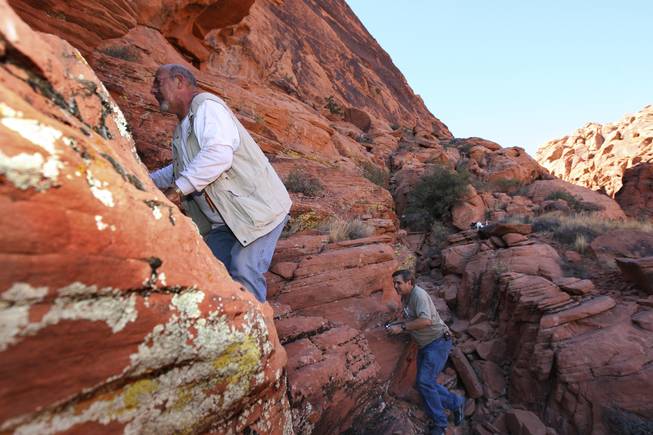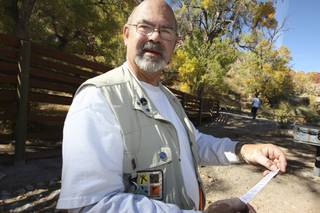
Mona Shield Payne / Special to the Home News
Traversing the ledges of steep red rock cliffs, John Sanderson and Lynn Storton, right, search for hidden geocache in Calico Basin during the Nevada Geocachers Association’s hunt Saturday.
Friday, Nov. 21, 2008 | midnight
Seeking Hidden Treasures
The Nevada Geocachers Association hunt for treasures at Red Rock Canyon Calico Basin using GPS coordinates.
Related link
Before you think geocachers are totally uncool — and you can get that impression from their love of gadgets and swag boxes full of toy cars and Mardi Gras beads — get a look at Lynn Storton's tricked-out Jeep Wrangler.
It has 35-inch wheels and three Global Positioning System devices wired up inside. The self-described computer nerd admits he might be a bit obsessed. Storton, of Henderson, estimated he has spent about $1,500 on his hobby in the last five years.
"People are always looking for something to do," Storton said while driving his big Jeep into the vast open space of Red Rock recreation area. "Sometimes it's bowling. Sometimes it's hiking."
Sometimes it's this.
Geocachers use GPS devices to locate and leave behind caches of cheap goodies. The confederacy is worldwide. It resembles a scavenger hunt, except the clues are coordinates found on an Internet geocaching Web site and downloaded onto the GPS. The GPS knows two things — where you are and where the cache is. Then you walk, bike or drive until you get near it.
The first rule of geocaching: "If you take something, you leave something behind," said Cyndi Chidester, a Henderson mother who goes by the caching name Chidyfam. Her ammo can swag box contains several geocaching souvenirs, including an Atlanta Olympics 1996 glitter globe, toy cars and bead necklaces. Other than the fun of collecting curious swag, geocaching is a time for family bonding.
"You get to explore a lot of different areas," said Alex Chidester, her 13-year-old son. The family has searched for caches in the desert and cities. Some hide treasures in public parks.
Getting started is easy. Buy a GPS, find cache coordinates online and then start the hunt for the cache — which mostly amounts to dollar-store junk inside a water-proof container. A $60 GPS will get you there.
Storton, who coordinates a local group, said the next step for the new geocacher is to start planting caches. Then invest in "trackable items." Then join a group, like the Nevada Geocaching Association, to socialize. Often events, such as a recent potluck at the Calico Springs picnic area, attract 60 to 70 people.
On a recent Saturday afternoon search, Storton, 50, climbed up a cliff face to Calico Cave in Red Rock, but the cache eluded him and the other geocachers hunting for it. This is called a DNF, or "did not find."
"There's a place up here for it," said John Sanderson, a 64-year-old Henderson geocacher who goes by the name 2-old. His head was inside a small cave in the cliff. "But it's not here."
Storton figures a "muggle" snatched the cache. In the geocaching lexicon, a muggle is someone who is close by — such as hikers or joggers — but who are not part of the search group.
Besides the small caches of trinkets, some sites include trackable items, such as a stuffed animal. They are affixed with travel bugs that resemble dog tags and have a serial number printed on them. When the serial number is entered into the geocaching.com Web site, a travel history of that "bug" comes up.
Trackable items often have a goal, such as going to Europe, or being hidden in all 50 states.
Chidester has a "Welcome to Fabulous Las Vegas" key chain that was taken to Hong Kong. Now it's in Singapore. Her goal is to get it back to Southern Nevada. Trackable items are often small and easily transported, but geocachers here have stumbled upon a bowling ball or cinder block with a travel bug.
In addition to its own lexicon, geocaching has an inherent conflict: damage to the land caused by exploration. It's always on Storton's mind. The gas used to power his big Jeep. The trail that develops over time to a well-trod cache site.
"You have to be cautious that you're not destroying a site as you look for a cache," he said.
Becky Bosshart can be reached at 990-7748 or [email protected].


Join the Discussion:
Check this out for a full explanation of our conversion to the LiveFyre commenting system and instructions on how to sign up for an account.
Full comments policy